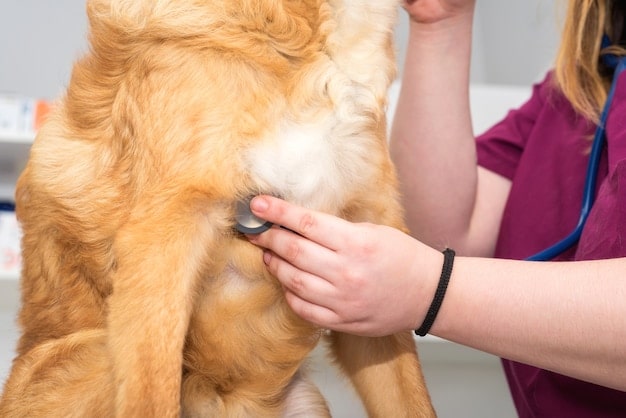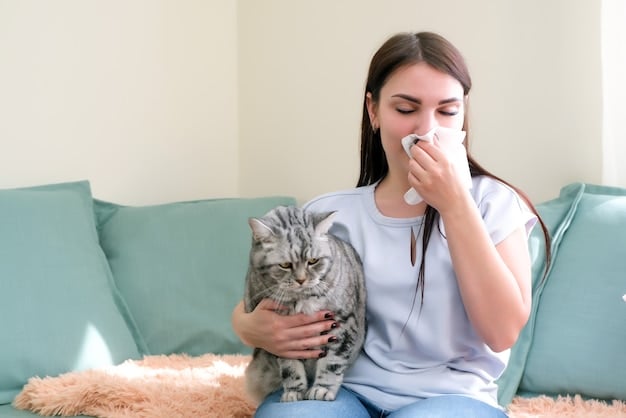End Pet Allergies Now: Breakthrough Treatments for Itchy Dogs & Cats

Is your dog or cat constantly scratching? Breakthrough allergy treatments can provide much-needed relief, addressing the root causes of itching and improving your pet’s quality of life.
Is Your Pet’s Itching Unbearable? Discover the Latest Breakthroughs in Allergy Treatments for Dogs and Cats, offering new hope and relief for your furry companions. Persistent scratching and discomfort can significantly impact their quality of life, but advancements in veterinary medicine are providing effective solutions to manage and alleviate allergy symptoms.
Understanding Pet Allergies: A Comprehensive Guide
Pet allergies are a common issue, affecting dogs and cats of all breeds and ages. Understanding the causes and symptoms is the first step in providing effective relief.
Common Allergens Affecting Pets
Just like humans, pets can be allergic to a wide range of substances. Identifying these allergens is crucial for effective management.
- Food Allergens: Certain ingredients in pet food, such as beef, chicken, or grains, can trigger allergic reactions.
- Environmental Allergens: Pollen, mold, dust mites, and other environmental factors can cause seasonal or year-round allergies.
- Flea Allergies: Flea saliva is a common allergen, leading to intense itching and skin irritation.
These allergens can cause a variety of symptoms, making accurate diagnosis essential.
Recognizing Allergy Symptoms in Dogs and Cats
Allergy symptoms can vary from mild to severe, affecting different parts of the body. Recognizing these symptoms early can prevent further discomfort.
Common symptoms include:
- Excessive Scratching: Persistent scratching, licking, or chewing at the skin.
- Skin Rashes and Irritation: Red, inflamed, or bumpy skin, often accompanied by hair loss.
- Ear Infections: Recurring ear infections, characterized by redness, discharge, and head shaking.
- Digestive Issues: Vomiting, diarrhea, or changes in appetite may indicate a food allergy.

By understanding the common allergens and recognizing the signs of allergies, pet owners can take proactive steps to address their pet’s discomfort.
Latest Breakthroughs in Allergy Testing
Accurate allergy testing is crucial for identifying the specific allergens affecting your pet. Recent advancements in testing methods have made the process more precise and less invasive.
Serological (Blood) Tests
Serological tests, or blood tests, measure the levels of specific antibodies in your pet’s blood. These antibodies are produced in response to allergens.
Key features of serological tests:
- Convenience: Blood samples can be easily collected during a routine vet visit.
- Wide Range of Allergens: Tests can screen for a large number of environmental and food allergens.
- Limitations: Results should be interpreted in conjunction with your pet’s clinical signs and history.
These tests provide valuable information to guide treatment strategies and dietary changes.
Intradermal Skin Testing
Intradermal skin testing involves injecting small amounts of allergens into the skin and observing the reaction. This method is often considered the gold standard for allergy testing.
Key aspects of intradermal skin testing:
- Accuracy: Provides detailed information about specific allergens causing reactions.
- Procedure: Requires sedation and careful monitoring by a veterinarian.
- Results: Reactions are typically assessed within 15-30 minutes of injection.
While more invasive than blood tests, intradermal skin testing can offer a more comprehensive understanding of your pet’s allergies.
Regardless of the testing method used, accurate results are vital for developing an effective allergy management plan.
Innovative Immunotherapy Options
Immunotherapy, also known as allergy shots or allergy drops, is a long-term treatment approach that aims to desensitize your pet to specific allergens. Recent advancements have made immunotherapy more effective and convenient.
Allergy Shots (Subcutaneous Immunotherapy)
Allergy shots involve injecting small, gradually increasing doses of allergens under the skin. This helps the immune system build tolerance over time.
Benefits of allergy shots:
- Proven Effectiveness: Shown to reduce allergy symptoms in many pets.
- Customized Treatment: Formulated based on your pet’s specific allergy test results.
- Long-Term Relief: Can provide lasting relief with regular administration.
Allergy shots require commitment and consistency but can significantly improve your pet’s quality of life.
Consistent administration and monitoring are key to the success of allergy shots.
Allergy Drops (Sublingual Immunotherapy)
Allergy drops are administered under the tongue, making them a less invasive alternative to allergy shots. This method is particularly appealing for pets that are sensitive to injections.
Advantages of allergy drops:
- Non-Invasive: Easier to administer, especially for anxious pets.
- Convenient: Can be given at home without frequent vet visits.
- Efficacy: Studies have shown promising results in reducing allergy symptoms.

Allergy drops offer a practical and comfortable option for long-term allergy management in pets.
Immunotherapy, whether through shots or drops, represents a significant advancement in allergy treatment, offering hope for long-term relief and improved well-being for your pets.
The Role of Diet in Managing Allergies
Diet plays a crucial role in managing pet allergies, particularly food allergies. Understanding the principles of hypoallergenic diets and the importance of ingredient selection can make a significant difference.
Hypoallergenic Diets
Hypoallergenic diets are formulated to minimize the risk of allergic reactions. These diets typically contain limited ingredients and novel protein sources.
Key features of hypoallergenic diets:
- Limited Ingredients: Fewer ingredients reduce the chances of exposure to common allergens.
- Novel Proteins: Proteins that your pet has never been exposed to, such as duck, venison, or rabbit.
- Hydrolyzed Proteins: Proteins that have been broken down into smaller pieces to minimize allergic reactions.
Transitioning to a hypoallergenic diet can help identify and manage food allergies effectively.
A careful and gradual transition to a hypoallergenic diet is essential for optimal results.
The Importance of Reading Food Labels
Reading food labels carefully is essential for identifying potential allergens and ensuring that your pet receives a safe and nutritious diet.
What to look for on food labels:
- Ingredient List: Check for common allergens such as beef, chicken, wheat, corn, and soy.
- Guaranteed Analysis: Ensures that the diet meets your pet’s nutritional needs.
- AAFCO Statement: Indicates that the diet is complete and balanced for your pet’s life stage.
By becoming a savvy label reader, you can make informed choices about your pet’s diet and health.
In short, diet is a cornerstone of allergy management, providing a means to control and minimize exposure to potential allergens.
Topical Treatments for Immediate Relief
Topical treatments can provide immediate relief from itching and skin irritation, complementing other allergy management strategies. Shampoos, sprays, and creams are available to soothe and protect your pet’s skin.
Medicated Shampoos
Medicated shampoos are designed to cleanse the skin, remove allergens, and reduce inflammation. These shampoos often contain ingredients like oatmeal, aloe vera, or corticosteroids.
Benefits of medicated shampoos:
- Soothes Itching: Provides immediate relief from scratching and discomfort.
- Reduces Inflammation: Calms irritated skin and promotes healing.
- Removes Allergens: Cleanses the skin to minimize allergen exposure.
Regular use of medicated shampoos can significantly improve your pet’s skin health and comfort.
Frequency of use should be determined based on your veterinarian’s recommendations.
Topical Sprays and Creams
Topical sprays and creams offer targeted relief for specific areas of skin irritation. These products often contain antihistamines, corticosteroids, or soothing agents.
Advantages of topical treatments:
- Targeted Relief: Applied directly to affected areas for localized relief.
- Convenient: Easy to use and can be applied at home.
- Quick Action: Provides rapid relief from itching and inflammation.
Topical treatments can be a valuable addition to your pet’s allergy management plan.
Topical treatments offer a practical and effective way to provide immediate relief from allergy symptoms.
Creating an Allergy-Friendly Home Environment
Managing your pet’s allergies goes beyond medical treatments and dietary changes. Creating an allergy-friendly home environment is crucial for minimizing exposure to allergens and supporting your pet’s overall well-being.
Regular Cleaning and Vacuuming
Regular cleaning and vacuuming can significantly reduce the levels of allergens in your home. Dust mites, pollen, and mold spores can accumulate in carpets, furniture, and bedding.
Tips for effective cleaning:
- Vacuum Frequently: Use a vacuum cleaner with a HEPA filter to trap allergens.
- Wash Bedding Regularly: Wash pet bedding in hot water to kill dust mites.
- Dust Regularly: Use a damp cloth to prevent allergens from becoming airborne.
By maintaining a clean home, you can minimize your pet’s exposure to common allergens.
Air Purifiers and Ventilation
Air purifiers and proper ventilation can help remove allergens from the air and improve indoor air quality. HEPA filters can trap pollen, mold spores, and dust mites.
Benefits of air purifiers and ventilation:
- Reduces Airborne Allergens: Removes particles that can trigger allergic reactions.
- Improves Air Quality: Provides a healthier environment for your pet.
- Controls Moisture: Reduces the risk of mold growth.
Creating an allergy-friendly home environment is an essential component of comprehensive allergy management.
By implementing these strategies, you can create a safer and more comfortable living space for your allergic pet.
| Key Point | Brief Description |
|---|---|
| 🐾 Allergy Symptoms | Recognize scratching, skin rashes, ear infections, and digestive issues. |
| 🧪 Allergy Testing | Blood tests and intradermal skin tests help identify specific allergens. |
| 💉 Immunotherapy | Allergy shots or drops desensitize pets to allergens over time. |
| 🏡 Home Environment | Regular cleaning and air purifiers reduce allergen levels at home. |
Frequently Asked Questions
▼
Common signs include excessive scratching, skin rashes, recurring ear infections, and digestive issues like vomiting or diarrhea. If your pet exhibits these symptoms, consult your veterinarian for a diagnosis.
▼
Your veterinarian can perform allergy testing, such as blood tests or intradermal skin tests, to identify specific allergens affecting your pet. These tests help tailor an effective treatment plan.
▼
While some natural remedies like oatmeal baths and certain supplements can provide relief, they may not be sufficient for severe allergies. Always consult your vet before starting any natural treatments.
▼
Immunotherapy can take several months to show noticeable improvements. It’s important to be patient and consistent with the treatment plan prescribed by your veterinarian for the best results.
▼
While it’s not always possible to prevent allergies, minimizing exposure to common allergens and maintaining a healthy diet can help. Regular vet check-ups can also aid in early detection and management.
Conclusion
Managing pet allergies requires a comprehensive approach that includes accurate testing, effective treatment, and a supportive home environment. By staying informed about the latest breakthroughs and working closely with your veterinarian, you can provide your furry friend with the relief they deserve and improve their overall quality of life.





